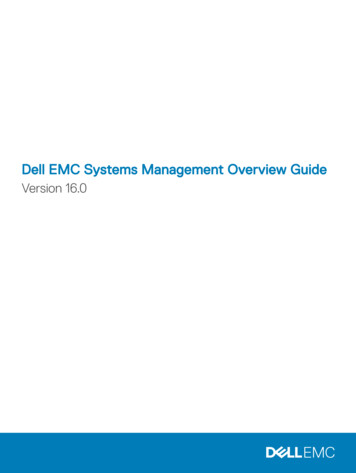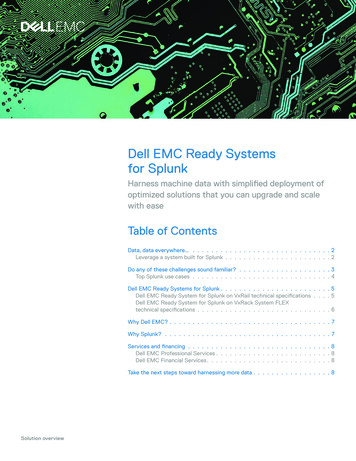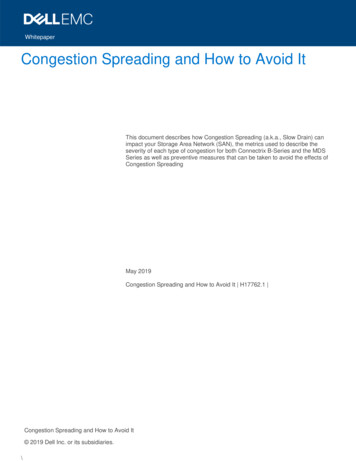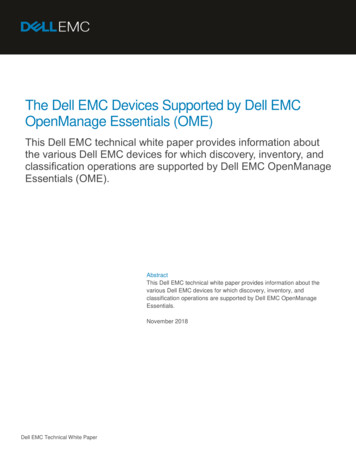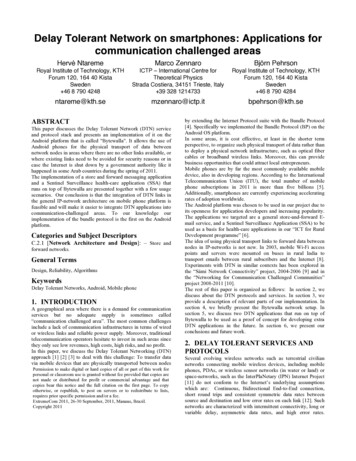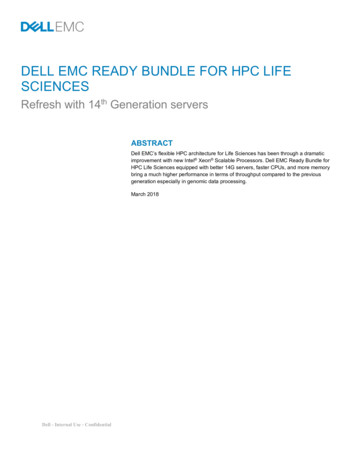
Transcription
DELL EMC READY BUNDLE FOR HPC LIFESCIENCESRefresh with 14th Generation serversABSTRACTDell EMC’s flexible HPC architecture for Life Sciences has been through a dramaticimprovement with new Intel Xeon Scalable Processors. Dell EMC Ready Bundle forHPC Life Sciences equipped with better 14G servers, faster CPUs, and more memorybring a much higher performance in terms of throughput compared to the previousgeneration especially in genomic data processing.March 2018Dell - Internal Use - Confidential
TABLE OF CONTENTSEXECUTIVE SUMMARY .3AUDIENCE . 3INTRODUCTION .4SOLUTION OVERVIEW .4Architecture . 4Compute and Management Components .5Storage Components .6Network Components .9Interconnect .10Software Components .10PERFORMANCE EVALUATION AND ANALYSIS . 11Aligner scalability. 11Genomics/NGS data analysis performance . 12The throughput of Dell HPC Solution for Life Sciences .13Molecular dynamics simulation software performance . 14Molecular dynamics application test configuration .14Amber benchmark suite .15LAMMPS .16Cryo-EM performance . 17CONCLUSION . 18APPENDIX A . 19APPENDIX B . 21REFERENCES . 22Dell - Internal Use - Confidential2
EXECUTIVE SUMMARYSince Dell EMC announced Dell EMC HPC solution for Life Science in September 2016, the current Dell EMC Ready Bundle for HPCLife Sciences can process 485 genomes per dayi with 64x C6420s and Dell EMC Isilon F800 in our benchmarking. This is roughly twofold improvement from Dell EMC HPC System for Life Science v.1.1 due to the introduction of Dell EMC’s14th generation servers whichinclude the latest Intel Xeon Scalable processors (code name: Skylake), updated server portfolio, improved memory, and storagesubsystem performance (1).This whitepaper describes the architectural changes and updates to the follow-on of Dell EMC HPC System for Life Science v1.1. Itexplains new features, demonstrates the benefits, and shows the improved performance.AUDIENCEThis document is intended for organizations interested in accelerating genomic research with advanced computing and datamanagement solutions. System administrators, solution architects, and others within those organizations constitute the target audience.Dell - Internal Use - Confidential3
INTRODUCTIONAlthough the successful completion of the Human Genome Project was announced on April 14, 2003 after a 13-year-long endeavor andnumerous exciting breakthroughs in technology and medicine, there’s still a lot of work ahead for understanding and using the humangenome. As an iterative advance in sequencing technology has accumulated, these cutting-edge technologies allow us to look at manydifferent perspectives or levels of genetic organization such as whole genome sequencing, copy number variations, chromosomalstructural variations, chromosomal methylation, global gene expression profiling, differentially expressed genes, and so on. However,despite the scores of data we generated, we still face the challenges of understanding the basic biology behind the human genome andthe mechanisms of human diseases. There will not be a better time than now to evaluate if we have overlooked the current approach,“analyze large numbers of diverse samples with the highest resolution possible” because analyzing a large number of sequencing dataalone has been unsuccessful to identify key genes/variants in many common diseases where majority of genetic variations seem to beinvolved randomly. This is the main reason that data integration becomes more important than before. We have no doubt that genomeresearch could help fight human disease; however, combining proteomics and clinical data with genomics data will increase thechances of winning the fight. As the life science community is gradually moving toward to data integration, Extract, Transform, Load(ETL) process will be a new burden to an IT department (2).Dell EMC Ready Bundle for HPC Life Sciences has been evolving to cover various needs for Life Science data analysis from a systemonly for Next Generation Sequencing (NGS) data processing to a system that can be used for Molecular Dynamics Simulations (MDS),Cryo-EM data analysis and De Novo assembly in addition to DNA sequencing data processing. Further, we are planning to cover moreapplications from other areas of Life Sciences and re-design the system suitable for data integration. In this project, we tested anadditional two Dell EMC Isilon storages as the importance of finding suitable storages for variable purposes grows. This is an additionalstep to build a HPC system as a tool to integrate all the cellular data, biochemistry, genomics, proteomics and biophysics into a singleframe of work and to be ready for the high-demanding era of ETL process.SOLUTION OVERVIEWEspecially, HPC in Life Sciences requires a flexible architecture to accommodate various system requirements. Dell EMC ReadyBundle for HPC Life Sciences was created to meet this need. It is a pre-integrated, tested, tuned, and leverages the most relevant ofDell EMC’s high-performance computing line of products and best-in-class partner products (3). It encompasses all of the hardwareresources required for various life sciences data analysis, while providing an optimal balance of compute density, energy efficiency andperformance.ARCHITECTUREDell EMC Ready Bundle for HPC Life Sciences provides high flexibility. The platform is available in three variants which are determinedby the cluster interconnect selected for the storages. In the current version, the following options are available: PowerEdge C6420 compute subsystem with Intel Omni-Path (OPA) fabric or Mellanox InfiniBand (IB) EDR fabrico Storage choices: Dell EMC Ready Bundle for HPC Lustre Storage as a performance scratch space Dell EMC Ready Bundle for HPC NFS Storage as a home directory space PowerEdge C6420 compute subsystem with 10/40GbE fabrico Storage choices: Either Dell EMC Isilon F800 or Dell EMC Isilon H600 as a performance scratch space Dell EMC Ready Bundle for HPC NFS Storage as a home directory space Add-on compute nodes:o Dell EMC PowerEdge R940 This server covers large memory applications such as De Novo Assemblyo Dell EMC PowerEdge C4130 A server for accelerators like NVIDIA GPUsIn addition to the compute, network, and storage options, there are several other components that perform different functions in the DellEMC Ready Bundle for HPC Life Sciences. These include CIFS gateway, fat node, acceleration node and other managementcomponents. Each of these components is described in detail in the subsequent section.The solutions are nearly identical for Intel OPA and IB EDR versions except for a few changes in the switching infrastructure andnetwork adapter. The solution ships in a deep and wide 48U rack enclosure, which helps to make PDU mounting and cableDell - Internal Use - Confidential4
management easier. Figure 1 shows the components of two fully loaded racks using 64x Dell EMC PowerEdge C6420 rack serverchassis as a compute subsystem, Dell EMC PowerEdge R940 as a fat node, Dell EMC PowerEdge C4130 as an accelerator node, DellEMC Ready Bundle for HPC NFS Storage, Dell EMC Ready Bundle for HPC Lustre Storage and Intel OPA as the cluster’s high speedinterconnect.Figure 1 Dell EMC Ready Bundle for HPC Life Sciences with Intel OPA fabricCompute and Management ComponentsThere are several considerations when selecting the servers for master node, login node, compute node, fat node and acceleratornode. For master node, 1U form factor Dell EMC PowerEdge R440 is recommended. The master node is responsible for managing thecompute nodes and optimizing the overall compute capacity. The login node (Dell EMC PowerEdge R640 is recommended) is used foruser access, compilations and job submissions. Usually, master and login nodes are the only nodes that communicate with the outsideworld, and they act as a middle point between the actual cluster and the outside network. For this reason, high availability can beprovided for master and login nodes. An example solution is illustrated in Figure 1, and the high-speed interconnect is configured to 2:1blocking fat tree topology with Intel OPA fabric.Dell - Internal Use - Confidential5
Ideally, the compute nodes in a cluster should be as identical as possible since the performance of parallel computation is bounded bythe slowest component in the cluster. Heterogeneous clusters do work, but it requires careful execution to achieve the bestperformance; however, for Life Sciences applications, heterogeneous clusters make perfect sense to handle completely independentworkloads such as DNA-Seq, De Novo assembly or Molecular Dynamics Simulations. These workloads require quite different hardwarecomponents. Hence, we recommend Dell EMC PowerEdge C6420 as a compute node to handle NGS data processing due to itsdensity, a wide choice of CPUs, and high maximum memory capacity. Dell EMC PowerEdge R940 is an optional node with 6TB ofRDIMM /LRDIMM memory and is recommended for customers who need to run applications requiring large memory such as De Novoassembly. Accelerators are used to speed up computationally intensive applications, such as molecular dynamics simulationapplications. We tested configurations G and K for this solution.The compute and management infrastructure consists of the following components. Computeo Dell EMC PowerEdge C6400 enclosure with 4x C6420 servers High-performance computing workloads, such as scientific simulations, seismic processing and data analytics, rely oncompute performance, memory bandwidth and overall server efficiency to reduce processing time and data centercosts. It provides an optimized compute and storage platform for HPC and scale-out workloads with up to four independenttwo-socket servers with flexible 24 x 2.5” or 12 x 3.5” high capacity storage in a compact 2U shared infrastructureplatform. It also supports up to 512GB of memory per server node, for a total of 2TB of memory in a highly dense and modular2U solution.o Dell EMC PowerEdge C4130 with up to four NVIDIA Tesla P100 or V100 GPUs It provides supercomputing agility and performance in an ultra-dense platform purpose-built for scale-out HPCworkloads. Speed through the most complex research, simulation and visualization problems in medicine, finance,energy exploration, and related fields without compromising on versatility or data center space. Get results faster with greater precision by combining up to two Intel Xeon E5-2690 v4 processors and up to four300W dual-width PCIe accelerators in each C4130 server. Support for an array of NVIDIA Tesla GPUs and IntelXeon Phi coprocessors, along with up to 256GB of DDR4 memory, gives you ultimate control in matching yourserver architecture to your specific performance requirements. This server is an optional component for molecular dynamics simulation applications.o Dell EMC PowerEdge R940 The Dell EMC PowerEdge R940 is a 4-socket, 3U platform, equipped with the Intel Xeon Platinum 8168 2.7GHz(24 cores per socket – 96 cores in server or 28 cores per socket – 112 cores in server with Intel Xeon Platinum8180(M) Processor) and is dubbed “the fat node,” because of its 6 TB of memory capacity. This server is an optional component that can be added to the solution for De Novo assembly, visualization and/orlarge statistical analysis. Managemento Dell EMC PowerEdge R440 for master node It is used by Bright Cluster Manager to provision, manage and monitor the cluster. Optionally, a high availability (HA) configuration is also available by adding an additional server and set them in anactive-passive HA state.o Dell EMC PowerEdge R640 for login node and CIFS gateway (optional) These components are optional. Typically, a master node can manage user logins without a problem. However, it is wise to separate login/jobscheduling from a master node when the number of users grows larger. The login node can also be configured in HAmode by adding an additional server. This optional CIFS gateway can help data transferring from NGS sequencers to a shared storage.Storage ComponentsThe storage infrastructure consists of the following components: Dell EMC Ready Bundle for HPC NFS Storage (NSS7.0-HA) (4)Dell EMC Ready Bundle for HPC Lustre Storage (4)Dell EMC Isilon Scale-out NAS Product Family; Dell EMC Isilon F800 All-flash (5)or Dell EMC Isilon Hybrid Scale-out NAS H600 (5)Dell - Internal Use - Confidential6
Dell EMC Ready Bundle for HPC NFS Storage (NSS7.0-HA)NSS 7.0 HA is designed to enhance the availability of storage services to the HPC cluster by using a pair of Dell EMC PowerEdgeservers with Dell EMC PowerVault storage arrays, Red Hat HA software stack. The two PowerEdge servers have shared access todisk-based Dell EMC PowerVault storage in a variety of capacities, and both are directly connected to the HPC cluster using Intel OPA, IB or 10GbE. The two servers are equipped with two fence devices: iDRAC8 Enterprise, and an APC Power Distribution Unit(PDU). If system failures occur on one server, the HA cluster will failover the storage service to the healthy server with the assistance ofthe two fence devices and also ensure that the failed server does not return to life without the administrator’s knowledge or control.Figure 2 NSS 7.0-HA configurationDell EMC Ready Bundle for HPC Lustre StorageThe Dell EMC Ready Bundle for HPC Lustre Storage, referred to as Dell EMC HPC Lustre Storage is designed for academic andindustry users who need to deploy a fully-supported, easy-to-use, high-throughput, scale-out and cost-effective parallel file systemstorage solution. Intel Enterprise Edition (EE) for Lustre software v.3.0. It is a scale-out storage solution appliance capable ofproviding a high performance and high availability storage system. Utilizing an intelligent, extensive and intuitive management interface,the Intel Manager for Lustre (IML) greatly simplifies deploying, managing and monitoring all the hardware and storage systemcomponents. It is easy to scale in capacity, performance or both, thereby providing a convenient path to expand in the future.The Dell EMC HPC Lustre Storage solution utilizes the 13th generation of enterprise Dell EMC PowerEdge servers and the latestgeneration of high-density PowerVault storage products. With full hardware and software support from Dell EMC and Intel, the DellEMC Ready Bundle for HPC Lustre Storage solution delivers a superior combination of performance, reliability, density, ease of useand cost-effectiveness.Dell - Internal Use - Confidential7
Figure 3 Lustre-based storage solution componentsDell EMC Isilon F800 All-flash and Dell EMC Isilon Hybrid Scale-out NSA H600A single Isilon storage cluster can host multiple node types to maximize deployment flexibility. Node types range from the Isilon F (AllFlash) to H (Hybrid), and A (Archive) nodes. Each provides a different optimization point for capacity, performance, and cost.Automated processes can be established that automatically migrate data from higher-performance, higher-cost nodes to more costeffective storage. Nodes can be added “on the fly,” with no disruption of user services. Additional nodes result in increased performance(including network interconnect), capacity and resiliency.The Dell EMC Isilon OneFS operating system powers all Dell EMC Isilon scale-out NAS storage solutions. OneFS also supportsadditional services for performance, security, and protection: SmartConnect is a software module that optimizes performance and availability by enabling intelligent client connection loadbalancing and failover support. Through a single host name, SmartConnect enables client connection load balancing anddynamic NFS failover and failback of client connections across storage nodes to provide optimal utilization of the clusterresources.SmartPools provides rule based movement of data through tiers within an Isilon cluster. Institutions can set up rules keepingthe higher performing nodes available for immediate access to data for computational needs and NL and HD series used forall other data. It does all this while keeping data within the same namespace, which can be especially useful in a large sharedresearch environment.SmartFail and Auto Balance ensure that data is protected across the entire cluster. There is no data loss in the event of anyfailure and no rebuild time necessary. This contrasts favorably with other file systems such as Lustre or GPFS as they havesignificant rebuild times and procedures in the event of failure with no guarantee of 100% data recovery.SmartQuotas help control and limit data growth. Evolving data acquisition and analysis modalities coupled with significantmovement and turnover of users can lead to significant consumption of space. Institutions without a comprehensive datamanagement plan or practice can rely on SmartQuotas to better manage growth.Through utilization of common network protocols such as CIFS/SMB, NFS, HDFS, and HTTP, Isilon can be accessed from any numberof machines by any number of users leveraging existing authentication services.Formerly known as “Project Nitro,” the highly dense, bladed-node architecture of F800 provides four nodes within a single 4U chassiswith capacity options ranging from 92TB to 924TB per chassis. Available in several configurations, F800 units can be combined into asingle cluster that provides up to 92.4PB of capacity and over 1.5TB/s of aggregate performance. It is designed for a wide range ofnext-generation applications and unstructured workloads that require extreme NAS performance including, 4K streaming of data,genomic sequencing, electronic design automation, and near real-time analytics. It can also be deployed as a new cluster, or canDell - Internal Use - Confidential8
seamlessly integrate with existing Isilon clusters to accelerate the performance of an enterprise data lake and lower the overall totalcost of ownership (TCO) of a multi-tiered all-flash and high capacity SATA solution. Powered by the OneFS operating system, this newoffering from Dell EMC is designed to provide the essential capabilities that enterprises require to modernize IT: extreme performance,massive scalability, operational flexibility, increased efficiency, and enterprise-grade data protection and security.Similarly, H600 also uses bladed-node architecture and has capacity options from 72TB to144TB per chassis. It is equipped with 120SAS drives, SSD caching, and built-in multiprotocol capabilities.Network ComponentsDell Networking H1048-OPFIntel Omni-Path Architecture (OPA) is an evolution of the Intel True Scale Fabric Cray Aries interconnect and internal Intel IP [9]. Incontrast to Intel True Scale Fabric edge switches that support 36 ports of InfiniBand QDR-40Gbps performance, the new Intel OmniPath fabric edge switches support 48 ports of 100Gbps performance. The switching latency for True Scale edge switches is 165ns175ns. The switching latency for the 48-port Omni-Path edge switch has been reduced to around 100ns-110ns. The Omni-Path hostfabric interface (HFI) MPI messaging rate is expected to be around 160 million messages per second (MMPS) with a link bandwidth of100Gbps.Figure 4 Dell Networking H1048-OPFMellanox SB7700This 36-port Non-blocking Managed InfiniBand EDR 100Gb/s Switch System provides the highest performing fabric solution in a 1Uform factor by delivering up to 7.2Tb/s of non-blocking bandwidth with 90ns port-to-port latency.Figure 5 Mellanox SB7700Dell Networking Z9100-ONThe Dell EMC Networking Z9100-ON is a 10/25/40/50/100GbE fixed switch purpose-built for applications in high-performance datacenter and computing environments. 1RU high-density 10/25/40/50/100GbE fixed switch with choice of up to 32 ports of 100GbE(QSFP28), 64 ports of 50GbE (QSFP ), 32 ports of 40GbE (QSFP ), 128 ports of 25GbE (QSFP ) or 128 2 ports of 10GbE (usingbreakout cable).Figure 6 Dell Networking Z9100-ONDell Networking S3048-ONDell - Internal Use - Confidential9
Management traffic typically communicates with the Baseboard Management Controller (BMC) on the compute nodes using IPMI. Themanagement network is used to push images or packages to the compute nodes from the master nodes and for reporting data fromclient to the master node. Dell EMC Networking S3048-ON is recommended for management network.Figure 7 Dell Networking S3048-ONInterconnectFigure 8 describes how the network components are configured for different storages. InfiniBand EDR connection uses MellanoxSB7700 switch, and the cable connections are identical to Dell Networking H1048-OPF. Either Intel OPA or IB EDR network isconfigured as 2:1 blocking fat tree topology.Figure 8 Illustration of Networking TopologySoftware ComponentsAlong with the hardware components, the solution includes the following software components: Bright Cluster Manager BioBuildsDell - Internal Use - Confidential10
Bright Cluster ManagerBright Computing is a commercial software that provides comprehensive software solutions for deploying and managing HPC clusters,big data clusters and OpenStack in the data center and in the cloud (6). Bright cluster Manager can be used to deploy completeclusters over bare metal and manage them effectively. Once the cluster is up and running, the graphical user interface monitors everysingle node and reports if it detects any software or hardware events.BioBuildsBioBuilds is a well maintained, versioned, and continuously growing collection of open-source bio-informatics tools from Lab7 (7). Theyare prebuilt and optimized for a variety of platforms and environments. BioBuilds solves most software challenges faced by the lifesciences domain. Imagine a newer version of a tool being released. Updating it may not be straight forward and would probably involve updatingall of the dependencies the software has as well. BioBuilds includes the software and its supporting dependencies for ease ofdeployment.Using BioBuilds among all of the collaborators can ensure reproducibility since everyone is running the same version of thesoftware. In short, it is a turnkey application package.PERFORMANCE EVALUATION AND ANALYSISALIGNER SCALABILITYThis is a base-line test to obtain information useful to set up fair performance tests. Burrows-Wheeler Aligner (BWA) short sequencealigner is tested here since it is a key application in variant analysis pipelines for whole genome sequencing data. There are more than90 short read alignment programs available as you can see in Figure 9 (8). Traditional sequence alignment tools like BLAST are notsuited for NGS. To extract meaningful information from NGS data, one needs to align millions and millions of mostly short sequences.BLAST and similar tools are way to slow for the vast amount of data produced by modern sequencing machines.Figure 9 Aligners currently availableDell - Internal Use - Confidential11
Hence, one might want to know what the best alignment software is; however, it is hard to answer to the question since the answer canbe drawn from many different conditions. Even if we could compare all different alignment software, there will not be any conclusionwhich alignment tool is the best. It really depends on your goals and the specific use case like the reason we choose to test BurrowsWheeler Aligner (BWA) is because it is a part of the popular variant calling workflow with Genome Analysis Toolkit (GATK) (9) (10).Nonetheless, one of many aligners, BWA, scales stably for different numbers of cores and various NGS data size with Dell EMCPowerEdge C6420. A single PowerEdge C6420 server is used to generate baseline performance metrics and ascertain the optimumnumber of cores for running BWA for these scaling tests.Figure 10 shows the run times of BWA on various sequence data sizes ranging from 2 to 208 million fragments (MF) and differentnumber of threads. Although the results show speed-up due to increasing core count in general, the optimum number of cores for BWAis in between 12 - 20.Figure 10 Scaling behavior of BWAGENOMICS/NGS DATA ANALYSIS PERFORMANCEA typical variant calling pipeline consists of three major steps 1) aligning sequence reads to a reference genome sequence; 2)identifying regions containing SNPs/InDels; and 3) performing preliminary downstream analysis. In the tested pipeline, BWA 0.7.2r1039 is used for the alignment step and Genome Analysis Tool Kit (GATK) is selected for the variant calling step. These areconsidered standard tools for aligning and variant calling in whole genome or exome sequencing data analysis. The version of GATKfor the tests is 3.6, and the actual workflow tested was obtained from the workshop, ‘GATK Best Practices and Beyond’. In thisworkshop, they introduce a new workflow with three phases. Best Practices Phase 1: Pre-processingBest Practices Phase 2A: Calling germline variantsBest Practices Phase 2B: Calling somatic variantsBest Practices Phase 3: Preliminary analysesHere we tested phase 1, phase 2A and phase 3 for a germline variant calling pipeline. The details of commands used in the benchmarkare in APPENDIX A. GRCh37 (Genome Reference Consortium Human build 37) was used as a reference genome sequence, and 30xwhole human genome sequencing data from the Illumina platinum genomes project, named ERR091571 1.fastq.gz andERR091571 2.fastq.gz were used for a baseline test (11).It is ideal to use non-identical sequence data for each run. However, it is extremely difficult to collect non-identical sequence datahaving more than 30x depth of coverage from the public domain. Hence, we used a single sequence data set for multiple simultaneousruns. A clear drawback of this practice is that the running time of Phase 2, Step 2 might not reflect the true running time as researcherstend to analyze multiple samples together. Also, this step is known to be less scalable. The running time of this step increases as theDell - Internal Use - Confidential12
number of samples increases. A subtle pitfall is a storage cache effect. Since all of the simultaneous runs will read/write roughly at thesame time, the run time would be shorter than real cases. Despite these built-in inaccuracies, this variant analysis performance test canprovide valuable insights to estimating how much resources are required for an identical or even similar analysis pipeline with a definedworkload.The throughput of Dell HPC Solution for Life SciencesTotal run time is the elapsed wall time from the earliest start of Phase 1, Step 1 to the latest completion of Phase 3, Step 2. Timemeasurement for each step is from the latest completion time of the previous step to the latest completion time of the current step asillustrated in Figure 11.Figure 11 Running time measurement methodFeeding multiple samples into an analytical pipeline is the simplest way to increase parallelism, and this practice will improve thethroughput of a system if a system is well designed to accommodate the sample load. In Figure 12, the throughputs in total number ofgenomes per day for all tests with various numbers of 30x whole genome sequencing data are summarized. The tests performed hereare designed to demonstrate performance at the server level, not for comparisons on individual components. At the same time, thetests were also designed to estimate the sizing information of Dell EMC Isilon F800/H600 and Dell EMC Lustre Storage. The datapoints
Since Dell EMC announced Dell EMC HPC solution for Life Science in September 2016, the current Dell EMC Ready Bundle for HPC . (NGS) data processing to a system that can be used for Molecular Dynamics Simulations (MDS), Cryo-EM data analysis and De Novo assembly in addition to DNA sequencing data processing. Further, we are planning to cover .




